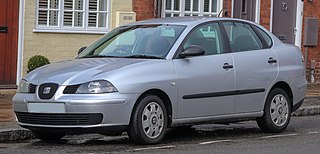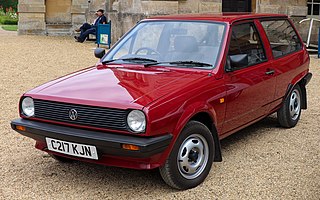
The Volkswagen Golf is a compact car/small family car (C-segment) produced by the German automotive manufacturer Volkswagen since 1974, marketed worldwide across eight generations, in various body configurations and under various nameplates – including as the Volkswagen Rabbit in the United States and Canada, and as the Volkswagen Caribe in Mexico (Mk1).

The Volkswagen Polo is a supermini car (B-segment) produced by the German car manufacturer Volkswagen since 1975. It is sold in Europe and other markets worldwide in hatchback, saloon, and estate variants throughout its production run.

The SEAT Ibiza is a supermini car that has been manufactured by Spanish car manufacturer SEAT since 1984. It is SEAT's best-selling car. The Ibiza is named after the Spanish island of Ibiza and was the second SEAT model to be named after a Spanish location, after the SEAT Málaga. It was introduced at the 1984 Paris Motor Show as the first car developed by SEAT as an independent company, although it was designed by SEAT in collaboration with well-known firms including Italdesign, Karmann, and Porsche.

The Volkswagen Gol is a subcompact car that has been manufactured by Volkswagen do Brasil since 1980 as Volkswagen's entry-level car in the Latin American market—where it succeeded the Volkswagen Type 1 (Fusca) and the Volkswagen Brasilia. Several variants of the Gol-derived Voyage and Parati were marketed in North America as the Volkswagen Fox from 1987 to 1993.

The Volkswagen Citi Golf is a right-hand drive 5-door hatchback manufactured and marketed by Volkswagen in South Africa from 1984 to 2009 as a facelifted version of the first generation Volkswagen Golf Mk1, which ceased production in Germany in 1983.
The Volkswagen Group A platform is an automobile platform shared among compact and mid-size cars of the Volkswagen Group.

The Škoda Fabia is a series of passenger cars produced by Czech manufacturer Škoda Auto since 1999. It is the successor of the Škoda Felicia, which was discontinued in 2001. The Fabia was available in hatchback, estate and saloon body styles at launch, and from 2007, the second generation was offered in hatchback and estate versions. The third generation Fabia was launched in 2015, and the fourth in 2021.

The SEAT Córdoba is the saloon, estate and coupé version of the SEAT Ibiza supermini car, built by the Spanish automaker SEAT. It was manufactured between 1993 and 2008, and was related to the second and third generations of the Ibiza.

The Volkswagen Group A0 platform is a series of automobile platforms shared among superminis of various marques of the Volkswagen Group.

Volkswagen Derby was the name first given by German automaker Volkswagen for the commercialization of the booted saloon (three-box) version of its Volkswagen Polo Mk1 supermini, between 1977 and 1981 in Europe. Later, the Derby name was used by the Mexican Volkswagen subsidiary for the Polo Classic Mk3 saloon on its domestic market in the mid-1990s.

The Volkswagen Polo Mk4 is the fourth generation of the Volkswagen Polo supermini car produced by the German manufacturer Volkswagen. It was marketed from early 2002 to 2010 in most countries except Argentina and the USA. It was manufactured in South Africa until 2017, it was sold as the Polo Vivo. The Mk4 replaced the Volkswagen Polo Mk3, while the Polo Vivo replaced the Citi Golf. In 2018 the Mk4 was replaced by the Volkswagen Polo Mk5 Polo Vivo. In Brazil, It was manufactured until 2014 with a second facelift called 9n4, It was replaced in 2017 by Volkswagen Polo Mk6.

The Volkswagen Polo Mk3 is the third generation of the Volkswagen Polo supermini car and was produced from 1994 until 2002, with a facelift at the end of 1999. It was available in hatchback, sedan and wagon body styles. Although the Polo Mk3 hatchback didn't share the same platform as the Seat Ibiza, saloon and estate models were rebadged as Seat Córdoba.

The Volkswagen Polo Mk2 is the second generation of the Volkswagen Polo supermini. It was produced from late 1981 until 1994. It received a major facelift in 1990 and was available in three different body styles, including a distinctive kammback-styled hatchback, nicknamed "breadvan" in the UK but referred to as a Steilheck in Germany. The sedan version typically received the name of Volkswagen Derby.

The Volkswagen Polo Mk1 is the first generation of the Volkswagen Polo supermini. It was produced from 1975 until 1981.

The Volkswagen Golf Mk4 is a compact car, the fourth generation of the Volkswagen Golf and the successor to the Volkswagen Golf Mk3. Launched in October 1997 for the 1998 model year, it was the best selling car in Europe in 2001.

The Volkswagen Golf Mk3 is a medium-sized compact family car. It is the third generation of the Volkswagen Golf and the successor to the Volkswagen Golf Mk2, which was produced by Volkswagen from August 1991 to 2002.

The Volkswagen Golf Mk2 is a hatchback, the second generation of the Volkswagen Golf and the successor to the Volkswagen Golf Mk1. It was Volkswagen's highest volume seller from 1983 and ended in (German) production in late 1992, to be replaced by the Volkswagen Golf Mk3. The Mk2 was larger than the Mk1; its wheelbase grew slightly, as did exterior dimensions. Weight was up accordingly by about 120 kg (260 lb). Exterior design, developed in-house by VW design director Schäfer, kept the general lines of its Giugiaro-designed predecessor, but was slightly more rounded. All told, about 6.3 million second-generation Golfs were built.

The Volkswagen Polo Mk5 is the fifth generation of the Polo, a supermini-class car manufactured by Volkswagen since 2009. The vehicle unveiled at the 2009 Geneva Motor Show in March 2009, while the three-door version was unveiled at the 2009 Frankfurt Motor Show in September 2009. A four-door long-wheelbase sedan version has been produced and sold outside Europe in several emerging markets since 2010 either as the Volkswagen Vento or the Volkswagen Polo sedan. A short-wheelbase sedan version was sold in India between 2016 and 2020 as the Volkswagen Ameo.

The automotive industry in Germany is one of the largest employers in the world, with a labor force of over 857,336 (2016) working in the industry.

In 2023, Spain produced 2.45 million cars which makes it the 8th largest automobile producer country in the world and the 2nd largest car manufacturer in Europe after Germany, a position in the ranking that it was still keeping in 2024.



















